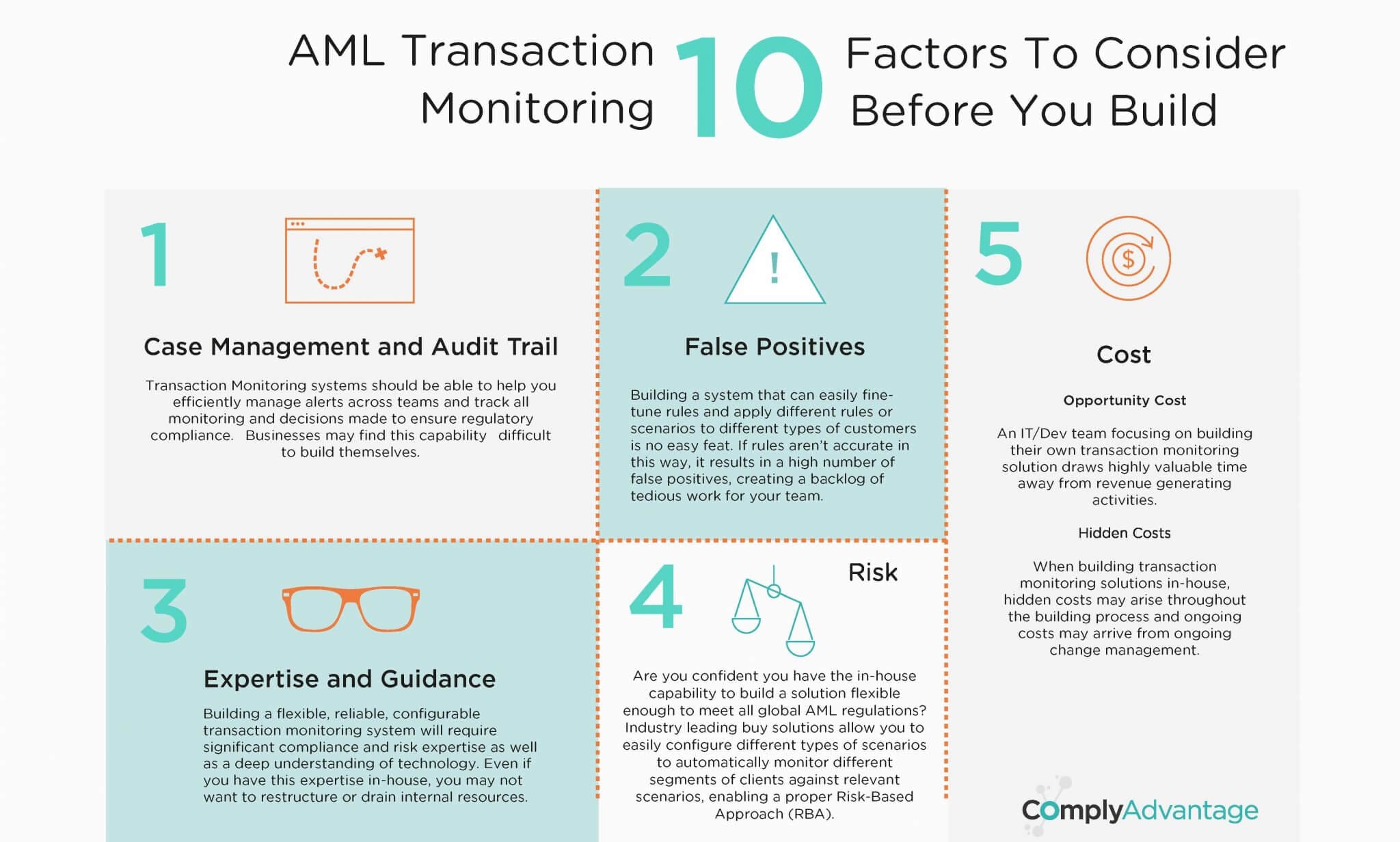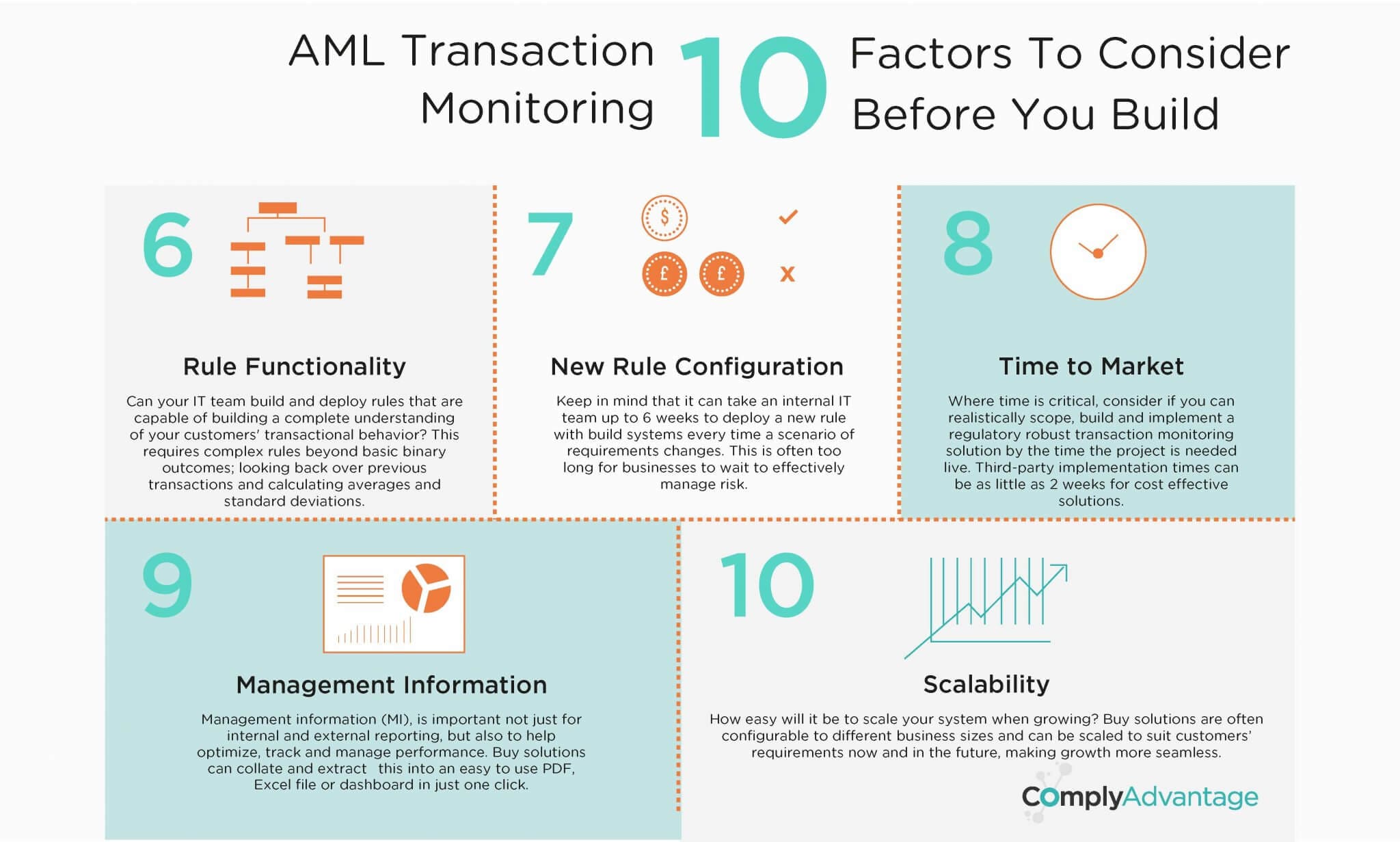 Featured
Featured
AML Transaction Monitoring: 10 Factors To Consider Before You Build
Transaction Monitoring Knowledge & TrainingTransaction monitoring is challenging. Suspicious activity for one customer is normal business for another. Typologies change constantly, false positives dominate compliance teams’ workflow, and the risk of missing something looms large. Commercial pressures around expansion and rapid growth are at odds with manual, labor-intensive compliance processes. Add increased global regulatory expectations set in last year’s NYDFS Part 504 and the EU’s 4th Money Laundering Directive, and businesses are increasingly looking to automated solutions to help monitor risk, meet regulations and keep banking partners happy.
- When deciding on the best transaction monitoring solution, many businesses are faced with the decision of building in-house or buying. Choosing the right approach is critical, and a lot can ride on the results – fines, high operational cost, personal and business risk.
- While every business is different, we believe that in many scenarios, buying over building a solution can help businesses better manage AML risk, be more cost effective and operationally efficient in the long run.
- There are many reasons to build however, probably 50% of the implementations we do are replacing internal systems that have been built in a hurry and are not fit for purpose.
Below we outline the challenges and considerations clients typically face and why they move away from in-house systems.
1. Case Management and Audit Trail
How easy is it going to be to escalate alerts to more senior staff members, add comments, add attachments and have an audit trail of all activity? Any solution ought to be able to help you efficiently manage alerts across teams, track all monitoring and decisions made to ensure regulatory compliance. However, this capability can be difficult to build and manage in-house, whereas third-party solutions will already have this system and process built in.
2. False Positives
With in-house systems many firms find it difficult to fine-tune rules and apply different rules or scenarios to different types of customers. If rules aren’t accurate in this way, it results in a high number of false positives, creating a backlog of tedious work for compliance officers. For this reason, many firms have opted for buy solutions.
3. Expertise and Guidance
How much specialist expertise is required, and how much do you have internally? Building a flexible, reliable, configurable transaction monitoring system will require significant compliance and risk expertise as well as a deep understanding of technology. Whilst some firms have this level of expertise in-house, businesses may not want to restructure or drain internal resources when third-party solutions often provide proactive and ongoing support.
4. Risk
The EU’s 4th Money Laundering Directive states that firms need to have consistent knowledge of their customers, the business and risk profile, including sources of funds. Likewise in the US with obligations from regulations such as the NYDFS Part 504. When weighing up these global requirements, your business may decide they’re not confident they have the ability to build a solution meeting them and that the personal and business risks associated with getting it wrong are too high.
At ComplyAdvantage, our solution can help you easily configure different types of scenarios, that automatically monitor different segments of clients against relevant scenarios. This is how we have helped our client Earthport to apply a proper Risk-based Approach (RBA) and to monitor risks more effectively, empowering their business to meet differing compliance regime requirements and risk profiles of their stakeholders.
5. Cost
a. Opportunity Cost
If your IT/Dev team switched focus for many weeks or even months to deliver this project, would this draw highly valuable time away from revenue-generating activities, such as improving front-end products, user experience and processing? You may want to consider third-party solutions after calculating the opportunity cost of their teams focusing on other activities.
b. Hidden Costs
Like many custom software developments, when building solutions in-house, hidden costs will probably arise throughout the building process, and costs may arise from on-going change management. It’s difficult to budget for these costs as they’re unpredictable, imposing financial risks on the business if they can’t be managed. Flexible, ready-to-implement buy solutions often offer a license fee inclusive of ongoing support and maintenance, de-risking businesses financial forecasting.
6. Rule Complexity
From our experience many firms find it difficult to deploy rules that extend beyond basic binary outcomes with systems that they have built in-house. To be able to understand a client’s normal behavior to then understand their suspicious behavior, you need to be able to build up a complete understanding of their transactional behavior; spotting patterns or trend deviations. This requires looking back over previous transactions and calculating averages and standard deviations – which is not straightforward.
7. New Rule Configuration
How easy is it going to be to configure or change a rule every time a scenario or requirement changes? We’re often told that it can take an internal IT team up to 6 weeks to deploy a new rule with in-house systems. Businesses are required to keep up with ever-changing risks and are constantly evolving, entering new markets and solving new problems. Many firms opt for third-party solutions, as 6 weeks isn’t fast enough for their ever-changing requirements.
8. Time to Market
9. Management Information
It’s important to obtain management information, not just for internal and external reporting, but also to help optimize, track and manage performance. If you build your transaction monitoring solution in-house, how easy it is going to be to collate and extract management information into an easy to use PDF, Excel file or dashboard in just one click? Many businesses opt for third-party solutions as they find it’s easier to buy this capability than build it themselves.
10. Scalability and Future Proofing
How easy will it be to scale your system when growing? How will transaction monitoring costs be managed when business requirements change, such as: maintenance, support, performance monitoring, new risks or regulatory amendments. Furthermore, when scaling, how many people will it take to deploy these changes, what will their annual salaries cost? Bought solutions are often configurable to different business sizes and can be scaled to suit customers’ requirements now and in the future, making growth more seamless.
Find out more about our transaction monitoring solution here
Originally published 23 July 2018, updated 05 October 2023
Disclaimer: This is for general information only. The information presented does not constitute legal advice. ComplyAdvantage accepts no responsibility for any information contained herein and disclaims and excludes any liability in respect of the contents or for action taken based on this information.
Copyright © 2024 IVXS UK Limited (trading as ComplyAdvantage).



 EN
EN FR
FR
